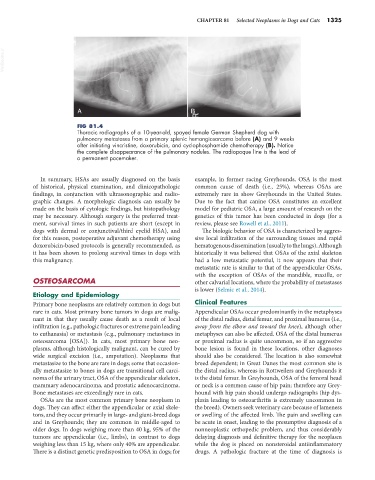Page 1353 - Small Animal Internal Medicine, 6th Edition
P. 1353
CHAPTER 81 Selected Neoplasms in Dogs and Cats 1325
VetBooks.ir
A B
FIG 81.4
Thoracic radiographs of a 10-year-old, spayed female German Shepherd dog with
pulmonary metastases from a primary splenic hemangiosarcoma before (A) and 9 weeks
after initiating vincristine, doxorubicin, and cyclophosphamide chemotherapy (B). Notice
the complete disappearance of the pulmonary nodules. The radiopaque line is the lead of
a permanent pacemaker.
In summary, HSAs are usually diagnosed on the basis example, in former racing Greyhounds, OSA is the most
of historical, physical examination, and clinicopathologic common cause of death (i.e., 25%), whereas OSAs are
findings, in conjunction with ultrasonographic and radio- extremely rare in show Greyhounds in the United States.
graphic changes. A morphologic diagnosis can usually be Due to the fact that canine OSA constitutes an excellent
made on the basis of cytologic findings, but histopathology model for pediatric OSA, a large amount of research on the
may be necessary. Although surgery is the preferred treat- genetics of this tumor has been conducted in dogs (for a
ment, survival times in such patients are short (except in review, please see Rowell et al., 2011).
dogs with dermal or conjunctival/third eyelid HSA), and The biologic behavior of OSA is characterized by aggres-
for this reason, postoperative adjuvant chemotherapy using sive local infiltration of the surrounding tissues and rapid
doxorubicin-based protocols is generally recommended, as hematogenous dissemination (usually to the lungs). Although
it has been shown to prolong survival times in dogs with historically it was believed that OSAs of the axial skeleton
this malignancy. had a low metastatic potential, it now appears that their
metastatic rate is similar to that of the appendicular OSAs,
with the exception of OSAs of the mandible, maxilla, or
OSTEOSARCOMA other calvarial locations, where the probability of metastases
is lower (Selmic et al., 2014).
Etiology and Epidemiology
Primary bone neoplasms are relatively common in dogs but Clinical Features
rare in cats. Most primary bone tumors in dogs are malig- Appendicular OSAs occur predominantly in the metaphyses
nant in that they usually cause death as a result of local of the distal radius, distal femur, and proximal humerus (i.e.,
infiltration (e.g., pathologic fractures or extreme pain leading away from the elbow and toward the knee), although other
to euthanasia) or metastasis (e.g., pulmonary metastases in metaphyses can also be affected. OSA of the distal humerus
osteosarcoma [OSA]). In cats, most primary bone neo- or proximal radius is quite uncommon, so if an aggressive
plasms, although histologically malignant, can be cured by bone lesion is found in these locations, other diagnoses
wide surgical excision (i.e., amputation). Neoplasms that should also be considered. The location is also somewhat
metastasize to the bone are rare in dogs; some that occasion- breed dependent; in Great Danes the most common site is
ally metastasize to bones in dogs are transitional cell carci- the distal radius, whereas in Rottweilers and Greyhounds it
noma of the urinary tract, OSA of the appendicular skeleton, is the distal femur. In Greyhounds, OSA of the femoral head
mammary adenocarcinoma, and prostatic adenocarcinoma. or neck is a common cause of hip pain; therefore any Grey-
Bone metastases are exceedingly rare in cats. hound with hip pain should undergo radiographs (hip dys-
OSAs are the most common primary bone neoplasm in plasia leading to osteoarthritis is extremely uncommon in
dogs. They can affect either the appendicular or axial skele- the breed). Owners seek veterinary care because of lameness
tons, and they occur primarily in large- and giant-breed dogs or swelling of the affected limb. The pain and swelling can
and in Greyhounds; they are common in middle-aged to be acute in onset, leading to the presumptive diagnosis of a
older dogs. In dogs weighing more than 40 kg, 95% of the nonneoplastic orthopedic problem, and thus considerably
tumors are appendicular (i.e., limbs), in contrast to dogs delaying diagnosis and definitive therapy for the neoplasm
weighing less than 15 kg, where only 40% are appendicular. while the dog is placed on nonsteroidal antiinflammatory
There is a distinct genetic predisposition to OSA in dogs; for drugs. A pathologic fracture at the time of diagnosis is

